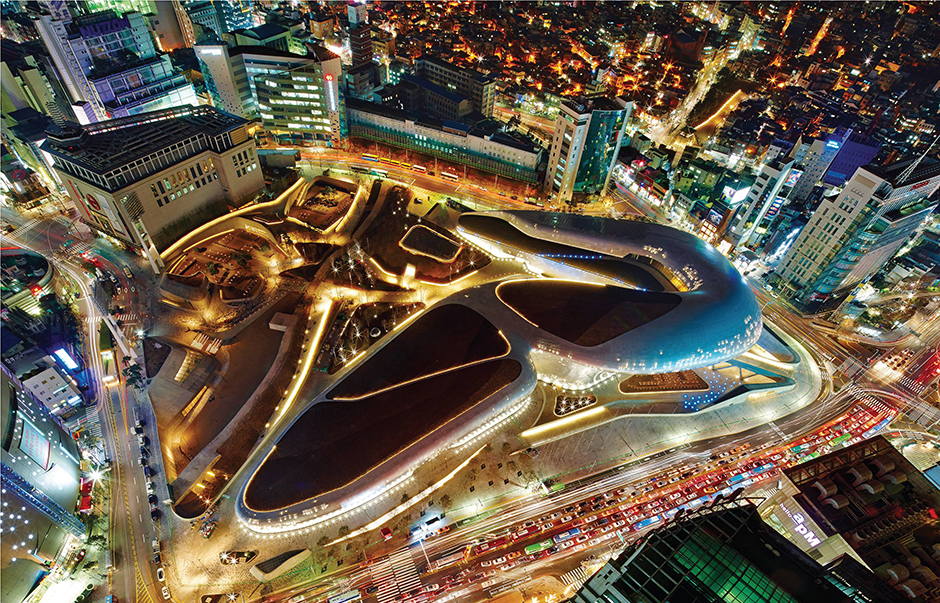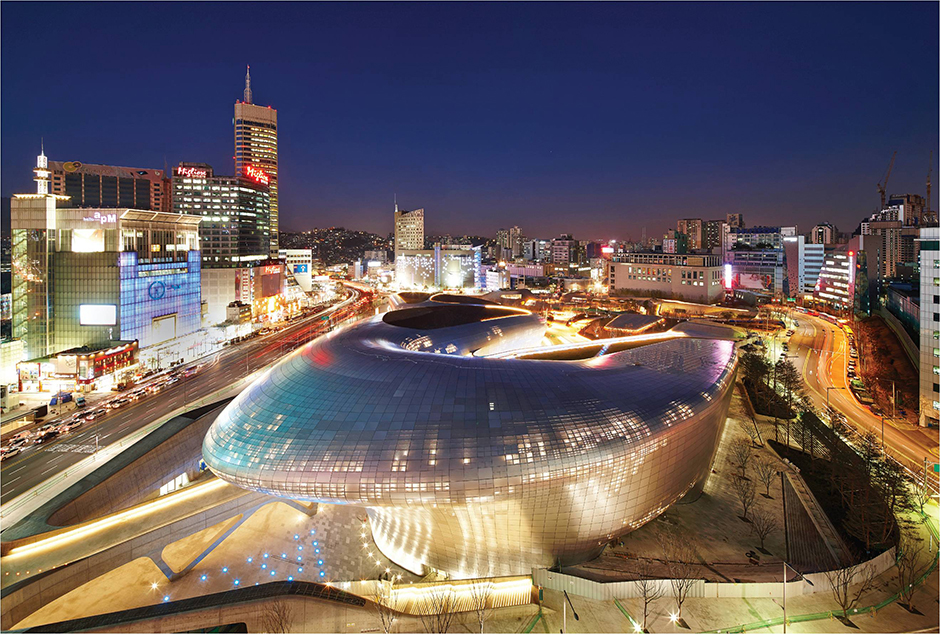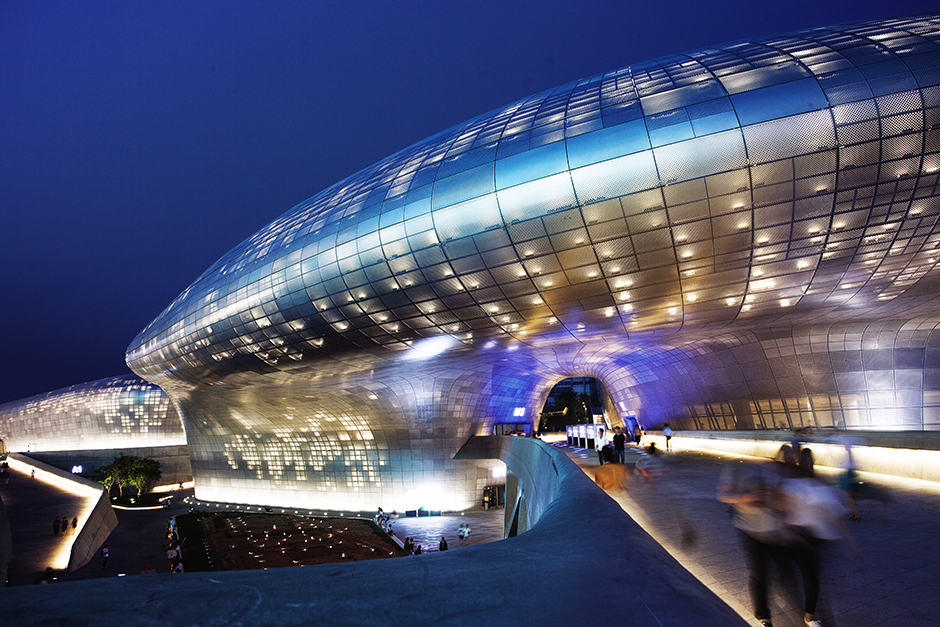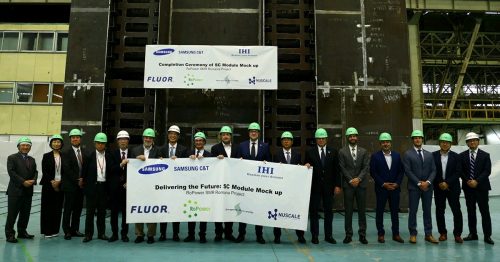One building that shuns conformity is Seoul’s Dongdaemun Design Plaza (DDP), the curvaceous exhibition and retail space that opened in 2014. Designed by Zaha Hadid and constructed by Samsung C&T Engineering & Construction Group, DDP flaunts curves and eschews sharp angles. Techniques and technologies applied to its construction can also be found elsewhere in our lives.
Taking a load off: Cantilevers and trusses
At first glance, what makes DDP distinctive is its supersized roof and huge overhang. In its construction, Samsung C&T employed cantilevers and trusses to realize Zaha Hadid’s unique vision.
A cantilever is a beam supported at one end and carrying a load at the other. The physics of cantilevers have long been known, and they have been used for centuries in bridges and balconies, where only one end of a load-bearing horizontal structure is supported.
Unlike a seesaw, where the fulcrum is in the middle between two loads, in a cantilever the fulcrum is at the supported end, leaving the load to seemingly hang in mid-air. Cantilever chairs, where just one or two legs bent in an L-shape hold up the entire weight of the sitter, are a good example. DDP’s cantilever gives it the unique look of a landed spaceship with a roof that overhangs the ground below.
Triangles cannot be distorted by stress, making them structurally strong. For this reason, triangular shapes called “trusses” are used to hold up heavy loads, for example in bridges. In DDP, extra-large steel trusses called “mega-trusses” have been applied three-dimensionally to create a “space frame” that maximizes the interior space without compromising the building’s structural soundness. The inside is expanded without the need for load-bearing pillars and columns.
Planes, ships and automobiles: Those are panels
What is so unusual about DDP’s exterior is that it has 45,133 exterior panels, each with a unique size, shape and curvature. These panels make up DDP’s distinctive round shell. Each had to be made separately in order to achieve the overall shape, but at the time of DDP’s construction there was not yet a manufacturing technique available to design and produce the panels in time and on budget; it would have taken almost two decades!
Samsung C&T scoured the world and found different types of technology used in manufacturing ships, airplanes, and automobiles that it combined into its own custom-built solution to achieve the desired result.
A multi-point stretch forming (MPSF) machine was developed using ideas and technology obtained from a Chinese research institute that was exploring new ways to fashion curved bows for ships.
Sheet metal can wrinkle, hurting its ability to maintain shape and strength under conditions of stress. This is unacceptable in a structure with so many curved panels, each expected to stay in position for many years. To avoid this in DDP, Samsung C&T utilized equipment used to pull sheet metal when making aircraft fuselages.
Once the panels had been pressed, a new technique was needed to cut them to the required shape and to punch multiple holes through each of them. This is where technology from the automobile industry was used to make a special robot with 5 axes or joints enabling it to access any part of each panel quickly and easily.
BIM: More than a drafter can do
An architectural drafter used to be able to draw detailed mechanical plans to construct a building using not much more than pencils, a set square, and a compass, but those days are well behind us. Not only has digitalization – computer assisted design – changed the work of drafters, but the increasingly complex structure of modern buildings means that two-dimensional plans are no longer sufficient.
In constructing DDP, Samsung C&T Engineering & Construction Group made full use of Building Information Modeling (BIM). The concept has existed since the 1970s and has since evolved and improved immeasurably. Bringing Zaha Hadid’s design for DDP to life would have been impossible without 3-dimensional BIM.
DDP was the first example in Korea where the BIM approach to specific aspects of construction was employed throughout the whole process. In fact, the exact shape, size and curvature of each of the 45,133 panels of the building’s outer shell was designed with BIM.
BIM is now used by Samsung C&T in smart construction of apartments and other buildings, even incorporating information gathered by drones.
DDP all around us
These disparate technologies from bridge construction to modern chairs, automobile and aircraft manufacturing, shipbuilding, and modern architectural drafting techniques all come together in DDP to make it the fluid and complex masterpiece that Seoul’s visitors and residents alike will admire for decades. They are also what makes DDP such a great place to visit – even though the building looks unusual and unfamiliar in many ways, there are also many parts that are familiar to us.











